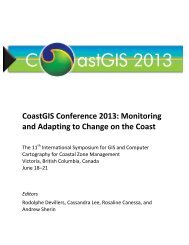in Context the SCotian Shelf - COINAtlantic
in Context the SCotian Shelf - COINAtlantic
in Context the SCotian Shelf - COINAtlantic
You also want an ePaper? Increase the reach of your titles
YUMPU automatically turns print PDFs into web optimized ePapers that Google loves.
<strong>in</strong> <strong>the</strong> offshore nest <strong>in</strong> <strong>the</strong> region; however, Sable<br />
Island has been designated a Migratory Bird Sancutary<br />
and is an important tern nest<strong>in</strong>g area. The<br />
endangered Roseate Terns nests on <strong>the</strong> island as<br />
do Common and Arctic Terns.<br />
The most abundant seabirds on <strong>the</strong> Scotian <strong>Shelf</strong><br />
are terns and large gulls (Gaston et al. 2009).<br />
The eastern Scotian <strong>Shelf</strong> has high numbers<br />
of w<strong>in</strong>ter<strong>in</strong>g Dovekie, Sooty Shearwaters and<br />
Greater Shearwaters (Brown 1988, Zwanenburg<br />
et al. 2006). The area generally marks <strong>the</strong> sou<strong>the</strong>rn<br />
w<strong>in</strong>ter<strong>in</strong>g range for species like <strong>the</strong> Thickbilled<br />
Murre, Common Murre, Atlantic Puff<strong>in</strong>,<br />
Nor<strong>the</strong>rn Fulmar, and Glaucous and Iceland gulls<br />
(Zwanenburg et al. 2006), although <strong>the</strong>re are a<br />
few breed<strong>in</strong>g colonies of Atlantic Puff<strong>in</strong>s <strong>in</strong> <strong>the</strong><br />
region (Lock et al. 1994). Dur<strong>in</strong>g <strong>the</strong> spr<strong>in</strong>g and<br />
fall migrations, <strong>the</strong> shelf also lies on <strong>the</strong> flyway<br />
for many species, <strong>in</strong>clud<strong>in</strong>g birds that nest along<br />
Nova Scotia’s coasts as well as those that nest<br />
much far<strong>the</strong>r north (Lock et al. 1994). Dur<strong>in</strong>g <strong>the</strong><br />
summer, Leach’s Storm Petrels nest on coastal<br />
islands but range widely offshore. The Wilson’s<br />
storm petrel can also be found <strong>in</strong> <strong>the</strong> region<br />
from <strong>the</strong> summer (sou<strong>the</strong>rn hemisphere w<strong>in</strong>ter),<br />
migrat<strong>in</strong>g from its sou<strong>the</strong>rn hemisphere breed<strong>in</strong>g<br />
grounds (Lock et al. 1994), as can <strong>the</strong> Greater<br />
and Sooty Shearwaters.<br />
In 2005, <strong>the</strong> Canadian Wildlife Service began<br />
a renewed effort to survey birds <strong>in</strong> <strong>the</strong> mar<strong>in</strong>e<br />
waters of Atlantic Canada (Gjerdrum et al. 2008).<br />
Results from <strong>the</strong>se surveys should improve <strong>the</strong><br />
understand<strong>in</strong>g of seabird distribution on <strong>the</strong> shelf<br />
and slope. More <strong>in</strong>formation on seabirds on <strong>the</strong><br />
Scotian <strong>Shelf</strong> and slope can be found <strong>in</strong> Brown<br />
(1986); Lock et al. (1994); Huettman (2000);<br />
Breeze et al. (2002); and Gaston et al. (2009).<br />
http://co<strong>in</strong>atlantic.ca/<strong>in</strong>dex.php/state-of-<strong>the</strong>-scotian-shelf<br />
25













